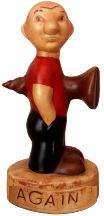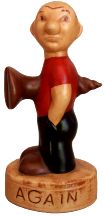 |
 The Virtual Corkscrew Museum's Weekly Newspaper |
 |
 |
 The Virtual Corkscrew Museum's Weekly Newspaper |
 |
|
Sunday, June 4, 2006 |
Brassies
Gainesville, Florida - John Cornell has a passion for corkscrews with decorative / historical brass handle. He lovingly refers to them as "Brassies". But it wasn't enough for John to just collect a wall full of over 300 brass handled corkscrews. Now his passion has grown into obsession. He wants to match up those brass handle corkscrews with handles on various other utilitarian objects. Like toasting forks for example - at latest count, he had over 400 of them. But so far he has matches for only eighteen corkscrews and toasting forks, ten of which are shown above*.
In a 1930s catalog from Pearson-Page-Jewsbuy, Soho Works, Western Road, Birmingham, England are 96 pages of these brass items. There are over 100 different designs on toasting fork handles shown(John has a long way to go). There are brushes, shovels, crumb scoops, door knockers, cork stoppers, button hooks, book markers, paper knives, shoe horns, crown cork openers, charms, hooks, corkscrews, and much more. Give John enough time and he'll probably find each of the objects with the same handle!
By profession, John is a statistician. Currently he is performing statistical analyses on bananas for Chiquita Foods. However, if you ask him about brassie statistics, he can probably tell you how often each object has turned up for sale on Internet auctions and the probability of finding a "brassie" in a Gainesville antique show. John would be happy to hear from others who collect toasting forks, brass or otherwise, if they are interested in trading duplicates, etc.
Pearson Page Jewsbury Co Ltd. was formed in 1933 with the merger of the John Jewsbury & Co. with Pearson Page Co. Jewsbury operated from at least 1913. Pearson-Page was in business in 1907 Both companies were in Birmingham. The new company took over Pearson Page designs when they were liquidated in 1933. In the mid 1940s Peerage Brass became the successor to Pearson-Page. They continued to make original designs as well as reproductions. The name "Peerage" is usually found on newer designs. The Peerage trademark apparently lapsed in 1991.
*The ten pairs shown are Caesar's Tower - Kenilworth; Elizabethian Galleon; Southwold Town Crier; John Peel; Through Moor & Dell I guide Ye Well; Dartmoor Pixies; Toothache; Dartmoor Pixies; Crasmere Church William Wordsworth; The Coracle Man.
An Unusual Mix
Somewhere - A reader who chose to remain anonymous writes "This unusual item that continues to intrigue me. I'd be very curious as to what various addicts think about an unusual 18th Century English pocket corkscrew that has a turned ivory handle, a black multifaceted steel shank and a gold sheath hallmarked 'WT'. There is very faint overall surface 'wear' to the sheath, and no indcation that it is not period."
Uff Da
Wirtz, Virginia - May 17 came and went and we forgot to wish our Norwegian readers a Happy Indepedence Day!
For more on Norwegian Independence Day and more Norway corkscrews, see the May 17, 2003 issue.
Flash Update
The list of reported Flash Corkscrews has grown to 284 (with some possible duplicates to eliminate when photos are compared). For the current list, click here.
Albert Alain - St. Raphael Connection
Paris, France - Here is a postcard from Studio Star, 78, Champs Elysées, Paris, France picturing Albert Alain extracting a cork from a bottle of St. Raphaël Quinquanna.
Editor's Note: Our research drew a blank when searching for information on Albert Alain. There was a composer by that name but unlikely he would have posed in this manner. Any readers have any details on Alain? Actor? Comedian? Clown? Or maybe Studio Star was a place for wannabee somethings to have their photo taken?
The following information with corkscrew photographs is reproduced from Corkscrew Stories Volume 2, ©2004 Donald A. Bull, Bullworks, Wirtz, Virginia, U. S. A.
St. Raphael
Raphael is the Patron Saint of Travelers. He is one of seven archangels who stand before the throne of God. A chap named Tobit was blind in his old age. Raphael was instrumental in restoring Tobit's sight and when it was done, he said "When you prayed with tears ... I offered your prayers to the Lord ... For I am the angel Raphael." Raphael is also the patron of the blind.
So how did St. Raphael get his name on this large knife (3 3/4" wide blade) with bakelite handles and a positive locking device for the worm?
Adémar Juppet lived in Lyon, France in the early 19th Century. He wanted to create a tonic quinine-based wine. He worked long hours and his vision went bad. He prayed that his eyesight would get better and if it did, he would dedicate his creation to the archangel Raphael.
In 1830, Juppet recovered and found success - the recipe for his dream. He named the apéritif St. Raphael Quinquina. The product was trademarked in 1890 by Adémar's son Pierre. In the early years, the archangel Raphael was shown on the label and in 1910 the archangel design was replaced by two waiters. One waiter was white and the other red to symbolize the two varieties of the product.
The two waiter's are shown on both sides of this waiter's friend knife with the advertisement "St. Raphael Quinquina."
Charles Loupot went to art school in Lyon in 1913, during a period when French poster art was in its prime. He began his career in Switzerland with fashion art posters. By 1923 he was a success and moved to Paris. There he won the poster contest promoted by the 1925 Exposition Internationale des Arts Decoratifs (where the term Art Deco was born). In the 1930s he designed the still famous two waiter logo for Raphael.
Rapahel's waiters can also be found in the WWII advertisment for Christmas 1939 shown above right.

|
©2006 Don Bull, Editor |